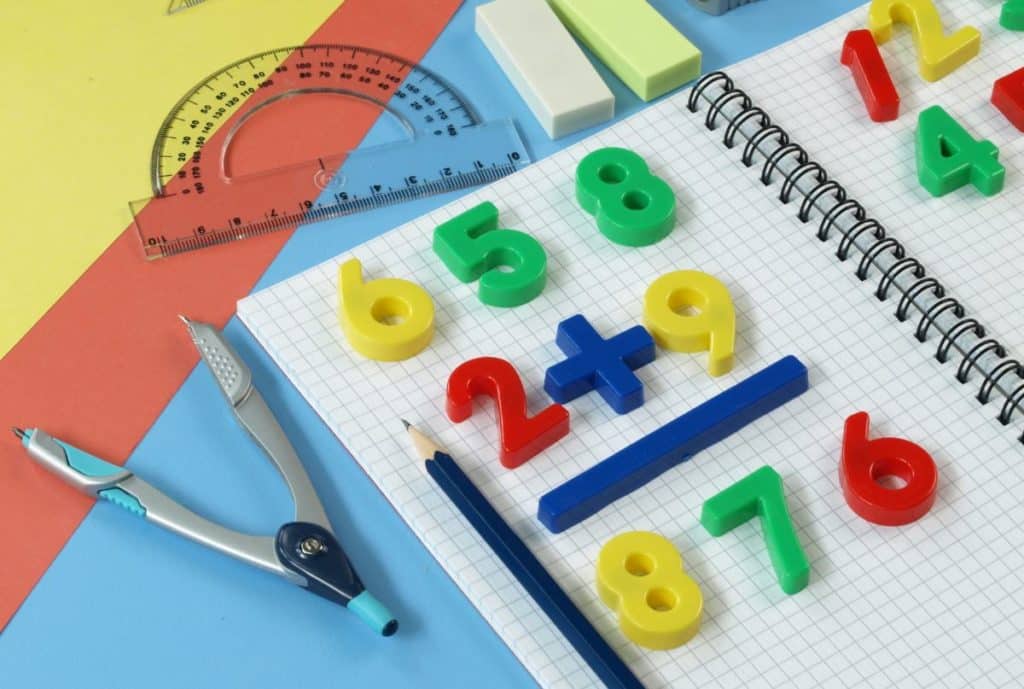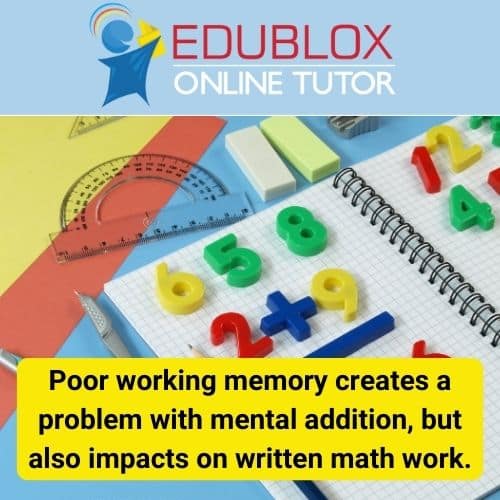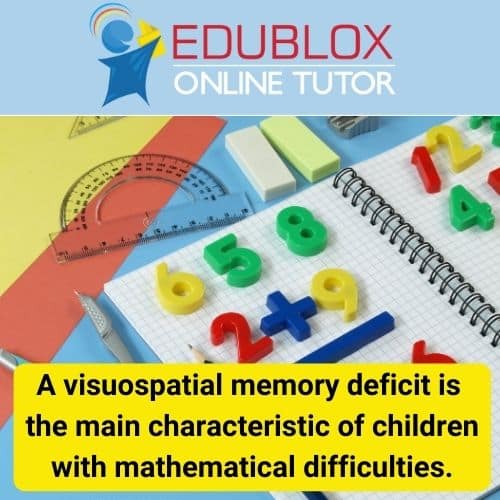
Math literacy is essential for survival in modern society. Everyday tasks such as paying bills or budgeting for daily expenses all have to do with numbers. Every job, from the rocket scientist to the sheepherder, requires math. In addition, decisions in life are often based on numerical information: to make the best choices, we need to be numerate.
Many factors may contribute to a child’s failure to master mathematics. Anxiety is one. Another is weak cognitive skills.
Cognitive skills are mental skills used in acquiring knowledge, manipulating information, reasoning, and problem-solving, and determine an individual’s learning ability. They separate the good and the so-so learners. In essence, when cognitive skills are strong, learning is fast and easy. Conversely, when cognitive skills are weak, learning becomes a challenge.
Below are the cognitive skills that play a crucial role in math. If any of these these cognitive are particularly weak, they may contribute to or even cause a math learning disability, also called dyscalculia.
Directional confusion
Directional confusion may take several forms, from being uncertain of which is left and right to being unable to read a map accurately. Directional confusion affects other concepts such as up and down, top and bottom, compass directions, keeping one’s place when playing games, being able to copy the gym teacher’s movements when they are facing you, and so on.
In math, children with directional confusion may form inverted numbers, for example, Ɛ for 3, or may be confused by the inconsistent ‘starting points’ of algorithms, for example, addition, where one starts at the right and works left with the answer appearing at the bottom of the sum, versus division, where one begins at the left and works right, and the answer appears at the top.
Sequencing difficulties
A sequence is a list of things that are in order. There are many sequences in mathematics. Indeed, the numbers 1–10 are the first experience of a mathematical sequence for most children.
There are mainly four types of sequences in math:
- An arithmetic sequence is a sequence in which every term is created by adding or subtracting a definite number to the preceding number,e.g., 3, 6, 9, 12, 15.
- A geometric sequence is a sequence in which every term is created by multiplying or dividing a definite number to the preceding number, e.g., 2, 4, 8, 16, 32.
- A harmonic sequence is a sequence in which the reciprocals of all the elements of the sequence form an arithmetic sequence and can not be zero, e.g., 1/2, 1/4, 1/6, 1/8, 1/10.
- A fibonacci sequence is a special type of sequence of numbers in which each term is created by adding its previous two elements, and the sequence starts with 0 and 1, e.g., 0, 1, 1, 2, 3, 5, 8, 11, 19,
Being able to recognize and remember sequences is a vital skill. Children often manage safe, familiar sequences such as 10, 20, 30, and 40, but fail to recognize variations such as 12, 22, 32, and 42.
Visual difficulties
These may include perceptual difficulties; for example, the student may confuse +,÷, and ×, or six and nine or three and five or x2 and x2 or the student may not see the decimal point.
The presentation style of a worksheet or exercise can be confusing and even overwhelming, especially if items are written too closely together, where the interaction between short-term memory difficulties and spatial tracking of the place on the page may cause the student to copy information inaccurately.
The pressure of having to work quickly in mathematics may exacerbate the problems of visual discrimination. For example, students may fail to notice that the operation symbol has changed from + to ×, and consequently, they perseverate with addition.
Spatial awareness
Spatial awareness is closely linked to visual difficulties. It is a complex cognitive skill that tells us our position relative to objects around us, and the relative position of objects to each other. It involves understanding the concepts of direction, distance, and location, and it’s at the heart of learning and performing countless tasks.
Spatial awareness is needed for work such as geometry, place value, algebra (distinguishing between 2x, x2, and x2, for example, where it could also be classed as problems with visual discrimination).
Short-term and working memory

The distinction between short-term memory and working memory is an ongoing debate as the terms are often used interchangeably. Some scholars insist that some kind of manipulation of remembered information is needed to qualify the task as one of working memory. Repeating digits in the same order they were presented would thus be a short-term memory task, while repeating them backward would be a working memory task.
Poor working memory can create several areas of difficulty and have a strong influence on how a student processes numbers. For example, a child trying to add 47 and 78 mentally has to hold the sum in their memory, probably work out 7 + 8 (poor long-term and retrieval memory for basic facts means they may well have to count on, thus increasing the time the original sum has to be held in memory), remember 5, carry 1, remember that they have to add 4 and 7 (and the carried 1), work out 7 + 4 + 1, recall the 5 and put them all together in the right (reverse) sequence as 125.
Poor working memory creates a problem with mental addition, but also impacts on written work, causing the student to use extra notations such as tally marks, which may lead to confusion and will certainly lead to slower work.
Long-term memory
Long-term memory is the memory process that takes information from the short-term memory store and creates long-lasting memories. These memories can be from an hour ago or several decades ago. While short-term memory is limited in space and duration, long-term memory has an immense capacity, and memories can last for a lifetime.
Rote learning as a means of loading information such as times table facts into long-term memory is rarely effective for students with math learning difficulties. Poor long-term memory may also handicap other areas of mathematics, such as recall of algorithms (methods) or formulae.
Visuospatial memory

Visuospatial memory is the ability to process and retain an object’s identity and spatial location, and is essential for many daily tasks.
Szűcs and team (2013) set out to compare various potential theories of dyscalculia in more than a thousand 9-year-old children. The researchers found that children with dyscalculia showed poor visuospatial memory performance. Furthermore, the results of a study by Mingozzi et al. (2023) led the researchers to recognize a visuospatial memory deficit as the main characteristic of children with mathematical difficulties.
Speed of working
Many of the factors described above, together with other factors such as speed of writing, affect the speed of work in mathematics, and speed of working is often an issue in mathematics.
Chinn (1995) compared the average time to stop work on 21 basic numeracy questions for a mainstream school population and a specialist dyslexia school population. According to the British Dyslexia Association, between 50 and 60% of students with dyslexia also have math difficulties. A population-based study by Landerl and Moll (2010) found that 23 to 49% of children in primary school had both dyslexia and dyscalculia. The results of Chinn’s pilot study showed that, on average, students with dyslexia took 50% longer to attempt the task.
Vocabulary
Mathematics has its own vocabulary and language. Much of its vocabulary is shared with non-mathematical uses, for example, ‘operation’ can be ÷,−,× or + in mathematics or, in everyday language, it is what takes place in a hospital. The semantics and language of mathematics can be very peculiar to mathematics and, in children’s eyes, they may be totally divorced from the language or realities of everyday life, bringing further problems for a child with learning disabilitiesc whose language skills may be weak.
To complicate the issue further, mathematics has its own collection of symbols, which are vital to an understanding of mathematics.
How to help
The good news is that cognitive weaknesses can be attacked head-on. Cognitive skills can be improved, strengthened, and enhanced through dynamic training and practice.
Edublox specializes in cognitive training and educational interventions that make children smarter, help them learn and read faster, and do math with ease. Our programs enable learners to overcome reading difficulties and other learning obstacles, assisting them to become life-long learners and empowering them to realize their highest educational goals.
Watch this playlist of customer reviews and experience how Edublox training and tutoring help turn dyslexia and dyscalculia around. Book a free consultation to discuss your child’s math learning needs.
.

